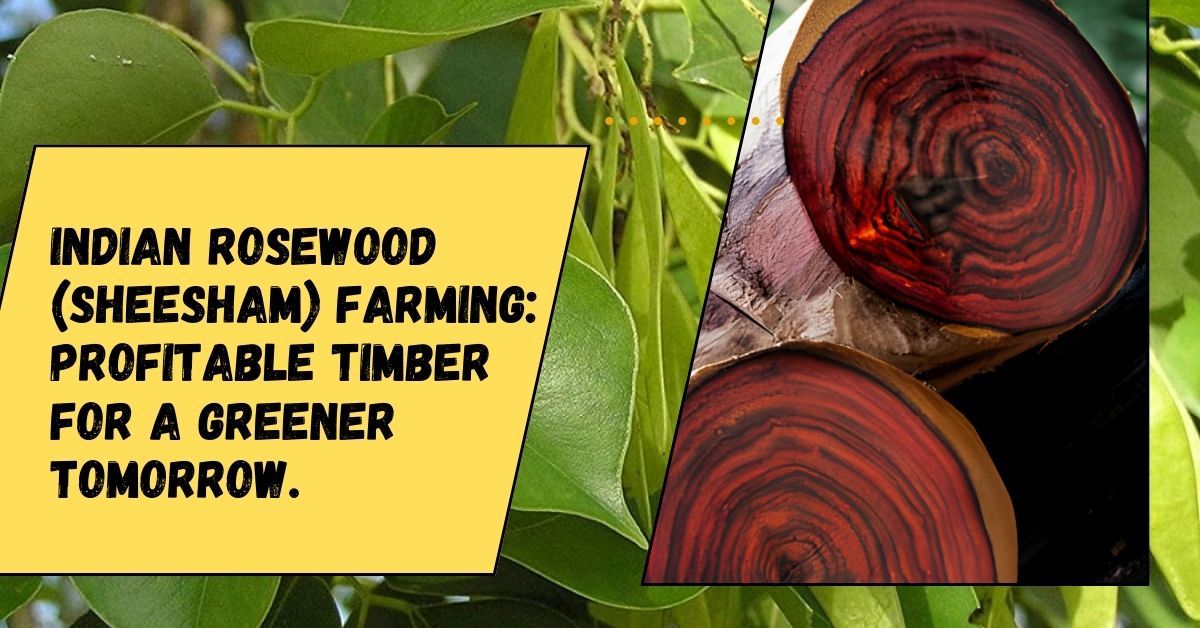Indian Rosewood (Sheesham) Farming: Profitable Timber for a Greener Tomorrow.
Indian Rosewood (Dalbergia sissoo), also called Sheesham, is one of India’s most popular and valuable hardwood trees. Its furniture-grade timber, resilience, and ecological benefits make sheesham plantation a smart choice for both farmers and investors. So let us know in this blog about Indian Rosewood (Sheesham) Farming

Why ChooseIndian Rosewood (Sheesham) Farming?
Premium Timber Value: Indian rosewood is highly demanded for fine furniture, flooring, and export, earning premium prices in the timber market.
Fast Growth: With good care, rosewood trees mature in 12–15 years, providing better and faster returns compared to many hardwood species.
Soil & Environment Friendly: Sheesham trees enrich soils, prevent erosion, and support local biodiversity.
Low Maintenance: After initial 2–3 years’ care, rosewood plantations require little maintenance.
Best Conditions for Indian Rosewood (Sheesham) Farming
Climate: Grows well in subtropical to tropical climates. Tolerates a wide variety of temperatures (10–40°C).
Soil: Prefers well-drained, fertile alluvial soils, but adapts to loam, sandy loam, and even slightly alkaline soils.
Rainfall: 900–2,000mm per year is ideal, but mature trees can withstand drought.
Steps to Grow Indian Rosewood (Sheesham)
1. Land Preparation
Clear the land, plough thoroughly, and apply organic manure.
2. Sapling Selection
Obtain disease-free, robust saplings (or seeds) from a certified nursery for best results.
3. Planting
Dig pits 45x45x45cm, fill with compost.
Spacing: 10–12 feet (3–4 metres) between trees.
Planting season: Pre-monsoon or early monsoon for better survival.
4. Irrigation & Maintenance
Young plants need regular watering; mature trees tolerate dry periods.
Weeding and mulching in first 2 years for strong growth.
Protect from grazing animals and waterlogging.
5. Harvest & Returns
Trees mature in 12–15 years; high-quality timber fetches top prices in the market.
Intermediate pruning can yield firewood or poles for additional income.
Pro Tips for Profitable Indian Rosewood (Sheesham) Farming
Regular thinning ensures straight, thick trunks—fetching best timber rates.
Intercrop with legumes or pulses for extra income and soil health.
Seek forestry department guidance for best management practices.
Conclusion
Indian Rosewood (Sheesham) farming is a sustainable, eco-friendly investment that secures long-term returns and supports green cover. For those planning a profitable agroforestry future, Sheesham is an ideal choice.
Click on the button below for plants or seeds.
Need premium rosewood seeds or expert plantation advice?
Connect with Annadata Trading Company for quality products and step-by-step farming support!
FAQs
1. What soil, climate, and growing conditions does Sheesham need?
Sheesham (Dalbergia sissoo) thrives in tropical to subtropical climates with temperatures around 18–35 °C. It tolerates droughts up to 3–4 months, rainfall up to ~2,000 mm, and grows well in well‑drained, fertile soils (sand, gravel, riverbank alluvium); seedlings tolerate full or partial sun; avoid waterlogged soils.
2. What are the propagation methods and seed germination rates for Sheesham?
Propagation is mostly by seeds or root suckers. Sheesham seeds remain viable only a few months. Before sowing, soak them in water for 12–48 hours; expect 60–80% germination within 1–3 weeks under favorable conditions.
3. How far apart should trees be planted, and what’s yield and growth time?
For hybrid plantings: 9 × 9 ft spacing; for mixed cropping or farm boundary planting: 15 × 15 ft or 8 × 8 ft margin spacing. Planting density roughly 500 trees per acre in hybrid pattern. Hybrids mature in 10–12 years, while native varieties may take 25 years or more.
4. What are pests/diseases that affect Sheesham, and are there resistant varieties?
A major fungal disease—Fusarium solani—causes dieback especially in trees around 20 years old, which is concerning since that’s peak productive age. Scientists have developed disease‑resistant hybrids to counter this.
5. What are economic benefits and uses of Sheesham wood?
Sheesham is prized for furniture, carving, cabinetry, flooring, ornamental and structural uses. It’s termite‑resistant, durable, and richly grained. Income through timber is significant if mature trees are sold. Also used for fuelwood, shade trees, and agroforestry.
